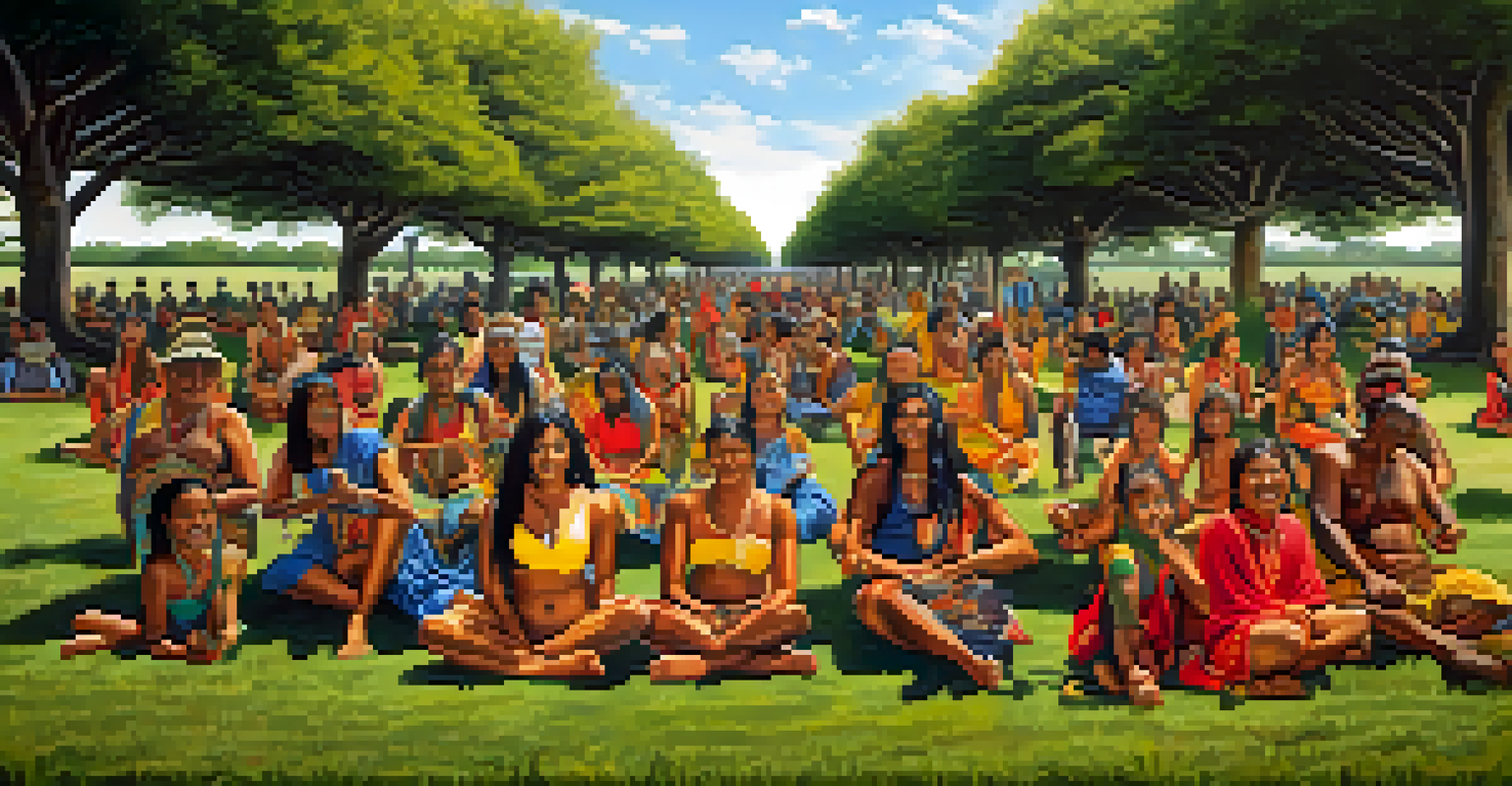Gender and Body Painting: A Study of Cultural Representation

Understanding Body Painting as a Cultural Expression
Body painting has long been a powerful form of cultural expression across various societies. This art form transcends mere aesthetics; it embodies beliefs, traditions, and the very essence of identity. For many cultures, body painting serves as a way to convey stories, celebrate rituals, or signify social status.
Art is a reflection of our society. It allows us to explore and express our identities, breaking down the barriers that define us.
In indigenous communities, for instance, body paint often represents spiritual beliefs and cultural heritage. Each color, pattern, and symbol has a significant meaning, connecting individuals to their ancestors and community. Thus, body painting is not just about decoration—it's a vital aspect of cultural identity.
As we delve into gender representation, we see how body painting varies dramatically between genders. This distinction highlights societal norms and expectations, revealing deeper insights into how different cultures perceive masculinity and femininity.
Gender Roles Reflected in Body Painting Practices
The practice of body painting often underscores traditional gender roles, with distinct styles and meanings attributed to different genders. For example, in some cultures, men may adorn their bodies with bold, aggressive patterns to signify strength and warrior status. In contrast, women might use softer, more intricate designs that celebrate beauty and fertility.

This division isn't just artistic; it reflects the broader societal norms that dictate how genders are perceived and valued. Such distinctions can reinforce stereotypes, suggesting that certain traits or roles are inherently linked to one's gender. In this way, body painting becomes a lens through which we can examine and critique these societal expectations.
Body Painting and Cultural Identity
Body painting serves as a profound form of cultural expression, embodying beliefs and traditions that connect individuals to their heritage.
Moreover, as societies evolve, so too do the meanings behind these practices. Contemporary artists often challenge traditional norms, using body painting to blur the lines between gender identities and celebrate fluidity.
Cultural Appropriation in Body Painting
Cultural appropriation is a significant issue in the realm of body painting, particularly when individuals from outside a culture adopt its symbols and practices without understanding their significance. This can lead to a dilution of meaning and can be seen as disrespectful to the cultures from which these practices originate.
Body art is a form of storytelling; it’s a way for individuals to communicate their experiences and identities visually.
For example, when Western artists use indigenous body painting styles in their work, they may strip away the deep cultural meanings and histories attached to those designs. This act often reduces rich traditions to mere aesthetics, which can be problematic and hurtful to the communities being represented.
It's crucial for artists and enthusiasts alike to approach body painting with respect and awareness. Engaging in conversations with cultural bearers and understanding the context behind the art can foster appreciation rather than appropriation.
Body Painting as a Form of Feminist Expression
In recent years, body painting has emerged as a powerful tool for feminist expression. Many women are reclaiming their bodies through body art, using it as a canvas to challenge societal norms and celebrate their identities. This movement often focuses on breaking free from traditional beauty standards, allowing women to express themselves boldly.
Artists such as Guido Daniele have created stunning works that blur the lines between body art and empowerment. By transforming the human body into a living, breathing artwork, they provoke thought around issues of body image and gender identity. This form of expression sends a message that women's bodies are not merely objects to be viewed but can be powerful statements in their own right.
Gender Roles in Body Art
The practice of body painting reflects traditional gender roles, showcasing how different cultures perceive masculinity and femininity.
Through body painting, women are not only asserting their individuality but are also engaging in a larger conversation about gender equality and representation. This evolving narrative showcases the potential of art to inspire change and foster understanding.
The Role of Male Identity in Body Painting
While body painting often highlights female experiences, it also plays a significant role in expressing male identities. Men, too, use body art to explore masculinity and vulnerability, challenging conventional perceptions of what it means to be a man. This exploration can lead to a more nuanced understanding of gender dynamics.
For instance, some male artists incorporate softer motifs and colors traditionally associated with femininity in their body art. By doing so, they disrupt the stereotype that masculinity must be synonymous with aggression and toughness. This shift encourages a broader dialogue about the spectrum of gender expression.
Ultimately, body painting allows men to engage in self-exploration and redefine their identities. By embracing diverse representations, society can foster a more inclusive understanding of masculinity that celebrates vulnerability and emotional expression.
Global Perspectives on Gender and Body Painting
Across the globe, body painting practices vary widely, reflecting the rich tapestry of cultural beliefs surrounding gender. In Africa, for example, tribal body painting often symbolizes rites of passage, with specific designs linked to gender roles and societal expectations. These traditions provide a framework for understanding how different cultures perceive gender.
In contrast, some Indigenous Australian communities use body painting as a way to connect with the land and ancestors, with designs that may be gender-specific but are more focused on cultural storytelling. This illustrates how body painting can simultaneously convey gender and cultural narratives, enriching our understanding of identity.
Body Painting's Evolving Narrative
As society evolves, body painting increasingly challenges outdated norms and advocates for inclusivity in the representation of gender identities.
By examining these global perspectives, we can appreciate the diversity of thought surrounding gender and body art. This appreciation fosters a greater understanding of how cultural contexts shape the meanings and implications of body painting practices worldwide.
The Future of Body Painting and Gender Representation
As society progresses, the future of body painting and its relationship with gender representation appears dynamic and evolving. Artists are increasingly breaking boundaries, using the human body as a canvas to challenge outdated norms and advocate for inclusivity. This shift signals a broader acceptance of diverse gender identities within the art world.
Moreover, digital platforms have allowed body painting to reach a wider audience, enabling artists to share their work and messages globally. This democratization of art fosters dialogue and encourages individuals to explore their own identities, often leading to a more profound understanding of gender fluidity.

Ultimately, the intersection of body painting and gender representation holds the potential to inspire change, challenge stereotypes, and celebrate the beauty of diversity. As we look to the future, the evolving narrative surrounding body painting will undoubtedly continue to reflect and influence societal perceptions of gender.